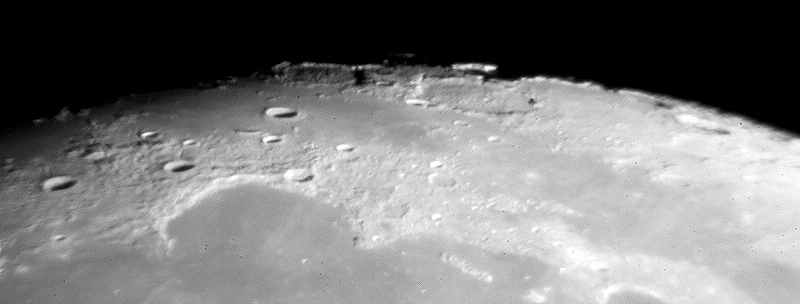
Moon Imaging with iPhone & D7000 DSLR on 8" LX200-ACF
Posted: 27 October 2012
Opened the observatory Friday, 26 October 2012, at 1811 MST, 73°F. The sky was generally clear but there were some high thin clouds visible in the western half of the sky. At 1816 MST, viewed Mercury, just above the western horizon, 77X. It appeared as just a small disk. Then viewed Mars, low in the southwestern sky, 77X. It also appeared as just a small disk, with no details visible. At 1820 MST, went to the waxing gibbous moon, 77X. Very bright in the 8" telescope. I then used 206X to take a tour along the terminator. Seeing was not good again this night, but the view of the north polar region was interesting.
I switched to the visual back and took this afocal, 77X, (cropped) image of the moon using the iPhone 4 mounted with the MX-1 adapter:

I then added the focal reducer and took this (cropped) image of the moon using the D7000 DSLR at prime focus, 1/400sec, ISO 100:

During post-processing of the DSLR image, I turned up "saturation" significantly to bring out the colors on the moon.
I removed the focal reducer and added a 3X TeleXtender to image the north polar region. This (cropped) image was taken using the "Hat Trick" Method, ISO 100:

I switched from prime focus imaging to eyepiece projection (222X) imaging and took this (cropped) image of the north polar region, "Hat Trick", ISO 200:

Ended imaging at 1928 MST and resumed lunar observing. Seeing was still not very good. At 1940 MST, I began watching sunrise at the crater Schickard, 206X. There was a fascinating view of light and shadows across the crater floor. Within 20 minutes, dramatic changes in the lighting had become very evident. It takes some patience to watch sunrise along the moon's terminator, but it is definitely rewarding.
At 2014 MST, I switched to 77X with a moon filter and enjoyed a view of the entire moon in the eyepiece. Lovely view.
At 2020 MST, it was getting breezy, so I decided to end this session. Closed the observatory at 2027 MST, 63°F.
Comments are welcome; use the Comments section below, or you can Email Me. Thanks.
Go to the previous report.
Return to the Cassiopeia Observatory Welcome Page.